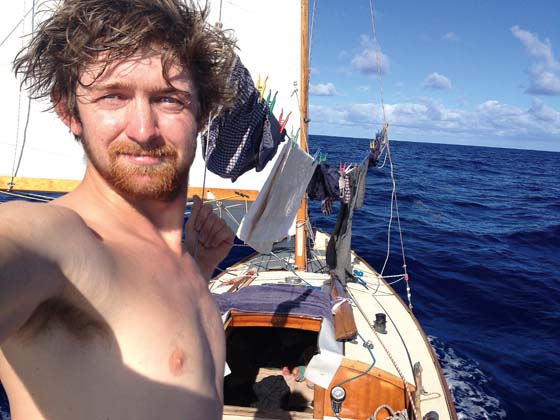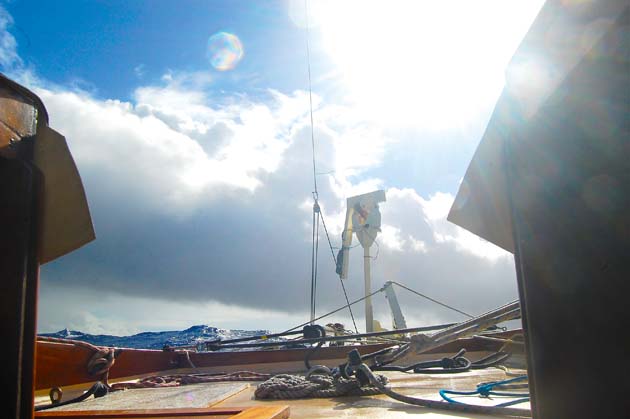Carrying his guitar, some fine wine, an old French racing bike and a sextant, Leo Goolden sets out on his first solo ocean crossing in a 24ft Folkboat
Across the Atlantic
So, one morning, I lifted my anchor, hoisted sail and was away again. I looked back at the land disappearing, and knew I wouldn’t see any more for several weeks. I felt elated and terrified, full of excitement and dread.
However, the weather was fair, the breeze strong, but comfortable and the barometer stable. I saw no boats during the first couple of days, so my sleeping schedule relaxed and I turned my alarm off. My body grew accustomed to the movement and sounds of the boat, and even small changes in condition woke me.
I ate plenty, cooking flatbreads on my trusty pump-up paraffin stove, and devouring packs of biscuits I had unsuccessfully tried to hide from myself. I tried to get through the mountain of fresh fruit and vegetables before they rotted. It led to some interesting meals.
After three days, the amount of Sargasso grass in the water started increasing. It stopped me fishing and got caught on the servo-pendulum for my windvane self-steering, causing Lorema to veer off course. I spent a day leaning perilously over the transom with a boathook to clear it, but as the grass increased, it became a real problem. Eventually, I took the whole steering system off, and tied the jib sheet to the tiller. After some experimentation with bungees, snatch blocks and different-sized jibs, I managed to get Lorema to steer herself downwind very well.
Navigation was the cornerstone of each day, and provided focus and structure. Three sunsights gave me a noon position, and after a while I worked out how to shoot stars and planets. With a couple of meals to cook, a beer at sunset, and a little music or reading, my days were pretty full.
But one of my big worries was an infection that started in my knee shortly after I left Cape Verde. As it swelled and became painful, thoughts of DIY amputation ran through my head. Thankfully, with medication it eventually went away.
There were other minor issues: a jammed halyard, some heavy squalls, some large seas, but nothing unmanageable. I spent hours dreaming up plans, wallowing in memories and possibilities. At times the movement of the boat would drive me almost to madness.
Life on board
When you try to do something as simple as making a cup of tea, and the waves insist on violently throwing you to the other side of the cabin, spilling your boiling tea, throwing your food around, and propelling knees and elbows and heads into sharp corners, it seems sometimes like a personal insult. But in time you learn to move in a different way, and to make do with less tea.
Sleeping also gets harder in big seas. Every unusual wave wakes you and provokes you to check outside for anything strange, and look for an approaching squall. These Atlantic squalls sometimes come through many times in a day, sometimes not at all. Sometimes they bring howling wind, sometimes just a short, but torrential shower. You can’t tell and so it’s necessary to reef the sails before they arrive each time. The fierce ones can be very fierce and would have no pity on the fool in a tiny boat flying a full main.
Generally, though, the winds were ideal, if a little on the strong side, and I spent my days and nights inspired and thoughtful, watching the sea go by, marvelling at the scale of the universe and the size of this ocean, and thinking about my tiny boat in the middle of it. The feeling was something between vulnerability, freedom, power and fear.
After 20 days, I found Martinique in the dark, and the sun rose as I rounded the island. The land looked fake, like a theatre backdrop, with flat boards layered behind each other to give the illusion of perspective. The colours were ridiculously vivid and the smell of the land was muddy, woody and wholesome. I found my way to a port, feeling thoroughly bizarre, dropped the anchor and rowed ashore.
Bearded and sunburnt and salty and tired, I ended up wobbling into a fast-food restaurant of all places, eager to find wi-fi and let my parents and friends know I had made it.
It was cold with the air conditioning and I nearly laughed out loud with the irony: I had sailed thousands of miles to be somewhere hot and beautiful and here I was in the Caribbean, freezing in McDonalds!
I finished my emails and escaped, then I filled my lungs with warm Caribbean air, feasted my eyes on the vivid colours and strolled off in search of a cold beer.
About Lorema
I bought Lorema in poor condition about three years ago. She had more than her fair share of rot, but she stood out in the harbour as something special. An engine-less Nordic Folkboat, she was built in Sweden in 1947, I think, although it has been hard to get information. One of the first times I sailed her, a chainplate pulled out of the planks and the mast came down.
By chance, I ended up at Gweek in Cornwall where, thanks to amazing generosity and good advice, I was able to rebuild the boat on an absolute shoestring and get sailing again ten months later. I gave her new planks, frames, transom, a new deck and mast, and an unusual decked over cockpit, which I did both for stowage and for seaworthiness in the ocean.
I renamed her Lorema after my grandmother, an amazing and inspirational woman.
After the relaunch I spent a summer sailing in Ireland and another winter working on various boatbuilding projects in Cornwall, before setting out south in May 2014. Lorema and I are now in Antigua, West Indies. www.sampsonboat.co.uk
This is an extract from a feature in the August 2015 issue of Yachting World








